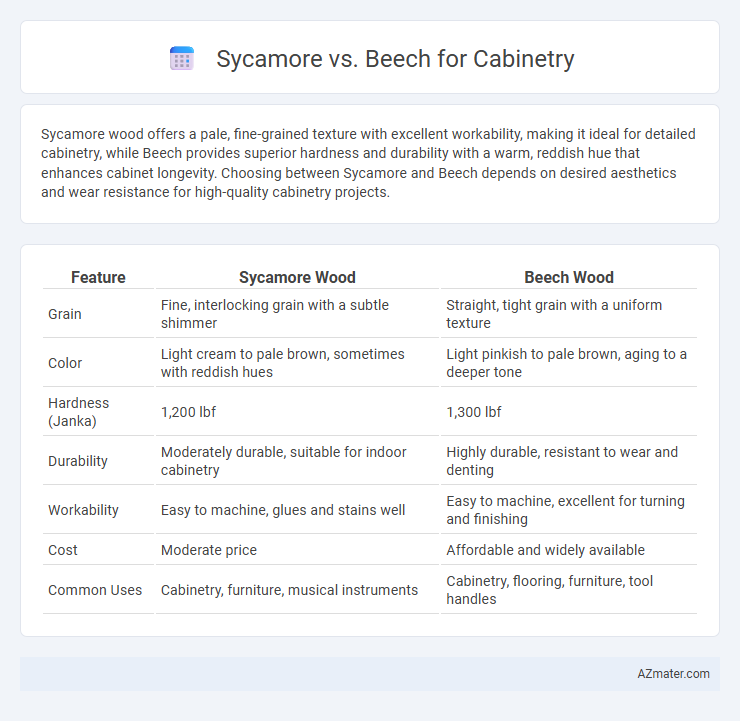Sycamore wood offers a pale, fine-grained texture with excellent workability, making it ideal for detailed cabinetry, while Beech provides superior hardness and durability with a warm, reddish hue that enhances cabinet longevity. Choosing between Sycamore and Beech depends on desired aesthetics and wear resistance for high-quality cabinetry projects.
Table of Comparison
| Feature | Sycamore Wood | Beech Wood |
|---|---|---|
| Grain | Fine, interlocking grain with a subtle shimmer | Straight, tight grain with a uniform texture |
| Color | Light cream to pale brown, sometimes with reddish hues | Light pinkish to pale brown, aging to a deeper tone |
| Hardness (Janka) | 1,200 lbf | 1,300 lbf |
| Durability | Moderately durable, suitable for indoor cabinetry | Highly durable, resistant to wear and denting |
| Workability | Easy to machine, glues and stains well | Easy to machine, excellent for turning and finishing |
| Cost | Moderate price | Affordable and widely available |
| Common Uses | Cabinetry, furniture, musical instruments | Cabinetry, flooring, furniture, tool handles |
Introduction to Sycamore and Beech for Cabinetry
Sycamore and beech are both popular hardwood choices for cabinetry, prized for their durability and aesthetic appeal. Sycamore wood is known for its light color, fine grain, and natural luster, often featuring subtle, curly patterns that add character to cabinet surfaces. Beech offers a consistent, tight grain with a warm, reddish hue, making it ideal for smooth finishes and traditional cabinet designs.
Wood Grain and Appearance Comparison
Sycamore features a distinctive, irregular grain pattern with a pale, creamy color that often includes subtle curls and patches, creating a unique, almost marbled appearance ideal for rustic or contemporary cabinetry. Beech exhibits a fine, straight grain with a uniform texture and a warm, light reddish-brown hue that darkens slightly over time, offering a more consistent and classic look for cabinetry. The contrasting grain complexity in sycamore versus the smooth, even grain of beech makes sycamore preferred for focal statement pieces, while beech suits traditional, understated cabinet designs.
Durability and Hardness: Sycamore vs Beech
Sycamore features a moderate Janka hardness rating of approximately 950, offering good resistance to dents and wear, while Beech scores higher around 1300, indicating superior hardness and durability for cabinetry. Beech's dense grain structure provides increased stability and resistance to impact compared to Sycamore's more porous texture, making Beech ideal for high-traffic kitchen environments. Choosing Beech results in longer-lasting cabinets with better resistance to scratches and everyday use, whereas Sycamore suits applications where moderate durability and unique grain patterns are preferred.
Workability: Which is Easier to Craft?
Sycamore wood offers excellent workability due to its fine, uniform texture and moderate hardness, making it easier to cut, shape, and sand for cabinetry projects. Beech, being a harder and denser hardwood, provides a smooth finish but can be more challenging to work with, especially when intricate detailing is required. Cabinetmakers often prefer sycamore for quicker, more precise crafting, while beech is chosen for its durability despite greater effort in machining.
Staining and Finishing Properties
Sycamore wood offers a smooth grain that takes stain unevenly, often resulting in a blotchy appearance if not pre-treated with a conditioner, while beech wood accepts stains uniformly, producing a more consistent and rich finish. Beech's tight grain and density allow for a smooth surface, making it easier to achieve a polished finish with both oil-based and water-based stains. Sycamore requires careful sanding and sealing to prevent absorption issues, whereas beech naturally provides a durable base that enhances the longevity and aesthetic quality of cabinetry finishes.
Cost and Availability Considerations
Sycamore cabinetry typically costs less due to its faster growth rate and wider availability across North America, making it a budget-friendly option for large projects. Beech, known for its durability and fine grain, tends to be more expensive because it is less abundant and primarily sourced from European forests. Availability of sycamore is generally more consistent, while beech may face supply fluctuations depending on regional logging regulations and import restrictions.
Environmental Sustainability of Sycamore and Beech
Sycamore wood is known for its rapid growth and widespread availability, making it a more sustainable option compared to slower-growing beech trees, which require longer maturation periods. Beech's dense grain and durability often lead to higher energy consumption during processing, whereas sycamore's lighter texture demands less energy, reducing overall environmental impact. Choosing sycamore cabinetry can contribute to forest conservation efforts and lower carbon footprints due to faster renewability and more efficient manufacturing processes.
Moisture Resistance and Stability
Sycamore exhibits moderate moisture resistance and is less prone to warping compared to beech, making it suitable for environments with variable humidity. Beech offers excellent dimensional stability but tends to absorb moisture more readily, which can lead to swelling in high-humidity areas. For cabinetry applications requiring sustained moisture resistance and stability, sycamore is often preferred due to its natural density and tighter grain structure.
Best Use Cases in Cabinetry Design
Sycamore's light color and smooth grain make it ideal for modern, minimalist cabinetry that highlights clean lines and bright spaces. Beech, with its fine, even texture and durability, suits traditional or rustic cabinetry styles where strength and a warm, reddish hue are prioritized. Sycamore excels in decorative applications, while beech is preferred for structural integrity and heavy-use kitchen cabinets.
Summary: Choosing Between Sycamore and Beech
Sycamore offers a lighter, creamy appearance with subtle grain patterns, providing a modern and airy aesthetic for cabinetry. Beech features a more uniform texture and a warm, reddish-brown tone that enhances traditional and classic kitchen designs. Selecting between Sycamore and Beech depends on the desired visual impact and durability needs, with Sycamore favored for its lightness and Beech prized for its robustness and ability to take stains evenly.

Infographic: Sycamore vs Beech for Cabinetry
 azmater.com
azmater.com